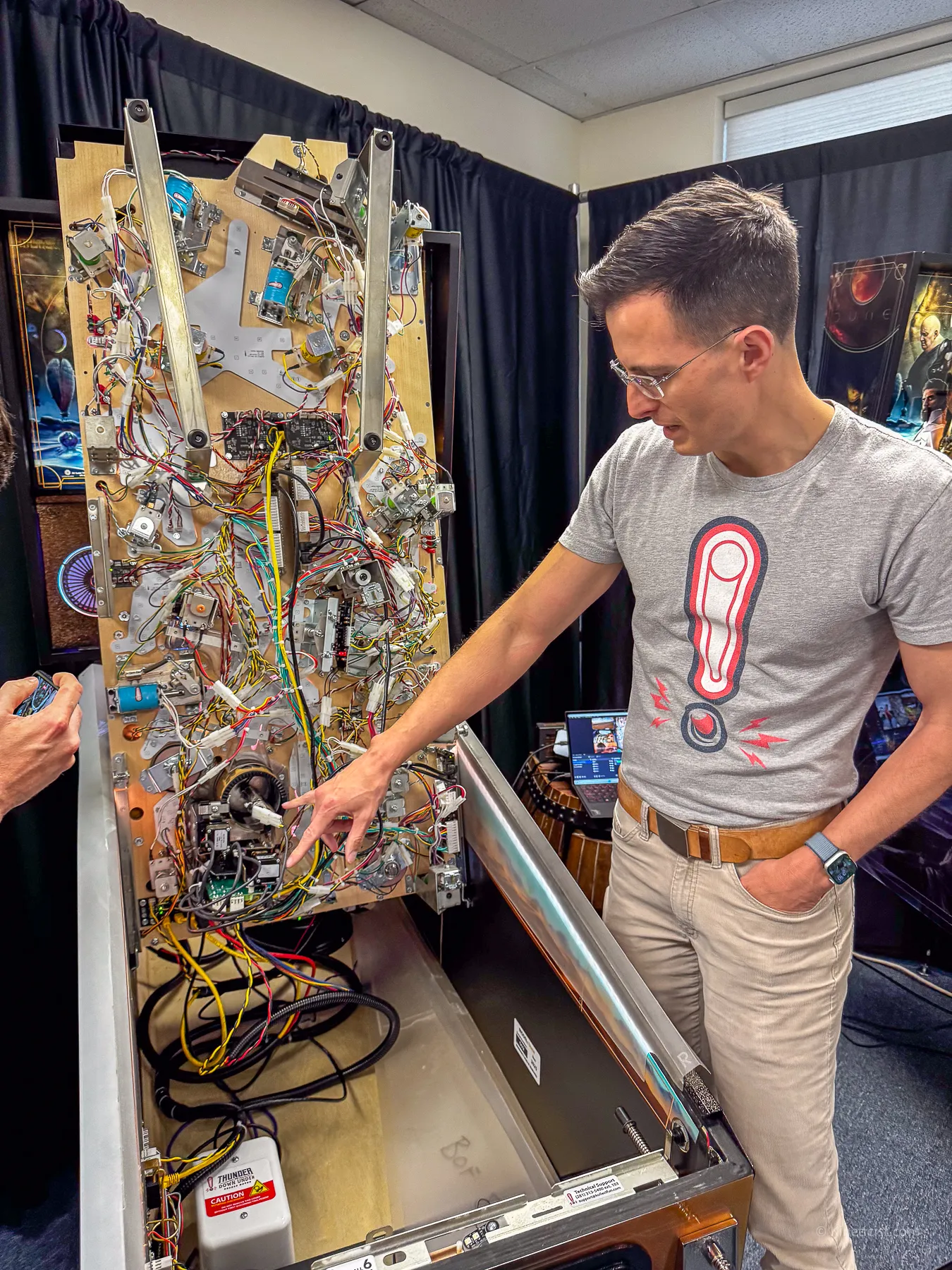Dune Pushes the Envelope for the Cinematic Pinball Experience

Image Gallery
What modern pinball machine provides a truly cinematic experience?
That was the question on my mind throughout a day spent at the Barrels of Fun production facility in Houston, Texas, for the launch of their newest game, Dune.

In informal community polling, pinball enthusiasts are quick to offer up games like Jersey Jack’s The Hobbit; Stern’s Lord of the Rings and JAWS; or Dutch Pinball’s Big Lebowski.
For pinball, these are all great examples of theme integration and the effective deployment of licensed assets. But, they always remind you, one way or another, that you’re playing a pinball machine, so I wouldn’t call them truly cinematic experiences.
A cinematic experience uses narrative storytelling, audio/visual techniques, and the environment to transport you to the world of the film and the characters within. Think about the last time you went to the movie theater and got lost in the viewing experience, or swept up in the drama and suspense of the story. The best cinematic experiences leave you with something to chew on long after the film ends.

Part of what makes director Dennis Villeneuve’s modern Dune adaptations so effective is that they turn the world of Dune into an epic cinematic experience. One that demands to be seen on the biggest screens with the best projectors and the finest audio systems. Doing this helps the viewer get lost in the grand sweeping visuals of cinematographer Greig Fraser or the brooding, dramatic Hans Zimmer score. You feel the pounding bass of the thumper or the controlled descent of a thopter kicking up fine particles of sand. It’s the kind of storytelling that cinema excels at, but pinball not so much.
Barrels of Fun’s Dune, however, excels at the act of translating a grand cinematic film experience into a grand cinematic pinball experience.

The Barrels of Fun team accomplishes this feat in several key ways, such as the acquisition of troves of licensed material like film clips, character callouts, actor likenesses, and music. There’s the detailed building of an authentic world under glass through extensive use of custom sculpts, interactive toys, and innovative mechanical features. Then there are the technological improvements like a newly integrated shaker motor, cabinet-integrated RGBW LED lighting, and upgraded sound system, thanks to a newly installed amplifier system. These combine with other improvements (like a more effective use of the game’s backboard LCD screen) to deliver a Dune pinball experience that’s exceptionally faithful to its source material.
Even on early code (CEO David Van Es described it as “beginner code”), Dune managed to deliver several wow moments, like when players start Desert Power multiball and the game’s highlight mech, the ball-eating interactive sandworm, latches onto the ball as the worm rotates and rises from the playfield and the Hans Zimmer score swells.
Or when starting the mode Ride, which triggers a repetitive, rhythmic thud from the game’s thumper bumper sculpt. There are other moments, too, like when players damage the Interactive Harkonnen Harvester, which triggers explosive visuals on the backboard LCD screen, or the tricky Bene Gesserit trial ball-save mode, which requires players to keep one hand on the center-action button while using the other hand to hit a specific playfield shot.

It’s the kind of game that demands to be played at home, in a dark room, with the sound turned way, way up.
Missing in this early code (Van Es stated that he expects the game to be code complete within 12 months) were more advanced asset integrations, like additional film clips, callouts, and music, but those are expected to come in time.
I found Dune to be initially challenging to shoot as its layout forces players to use all areas of the playfield, with some key shots in places that seemed like they should be easy to hit, but in practice were hard to find.

Once I did find them, however, the game is chock-full of flow with a ton of unique ball paths and satisfying shot geometry. I particularly enjoyed going for the Fedaykin Sand Trap on the right side of the playfield, exploring the multi-entry scoop, and the game’s three spinner shots.
I found Jonathan Bergeron’s art package for the game (particularly on the playfield) to be reminiscent of his work on Labyrinth (heavy use of browns and other earth tones, and opting for more of an illustrated hand-drawn style).
In person, there’s a lot more nuanced use of color than some of the initial visual assets might imply. Most importantly, I found the playfield easy to scan and digest quickly, so that I could lean into on-the-fly decision-making versus having to constantly find ways to slow the game down and figure out what to shoot next.

If there’s any knock on the current approach, it’s probably best reflected in the stylistic differences between the game’s stock backglass and the playfield. The backglass leans on more photo-realistic renditions of the film’s major characters, which feels slightly out of place within the context of other key art elements. I look forward to seeing the alternative backglass whenever that gets finalized, as I assume it will lean into a more original approach.
I think Dune is a game that pinball people are really going to enjoy once they get their hands on it and see more gameplay content in future streams and videos. Its approach to authentic cinematic immersion is one that I find to be both refreshing and quietly boundary-pushing for pinball. In fact, I could see it paving the way for more interesting and nuanced use of licensed IP that helps pinball evolve and grow into new audiences.
More Photos from the Barrels of Fun Dune Launch Event






















